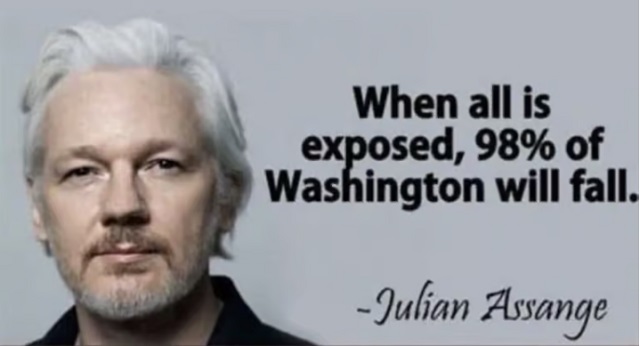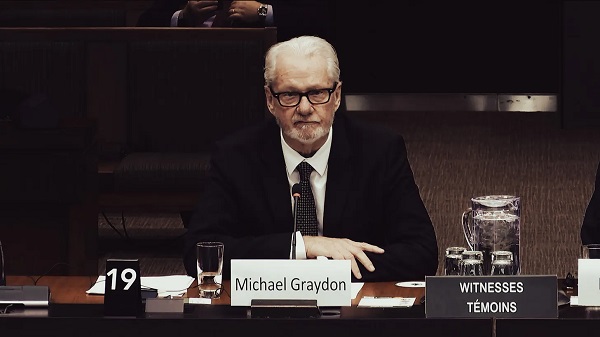Brownstone Institute
The Post-Ideological Age

Fr0m the Brownstone Institute
By
Conventional wisdom has it that the US and much of the Western world has polarized into right and left. These tribes are hard-core and share mutual loathing. That model of understanding pervades all popular media and consumes the culture, such that everyone feels the need to choose. It’s simple, harkens back to Cold War binaries, drums up media attention, and further divides the population in ways that benefit the leaders of both sides.
The reality underneath the surface is otherwise. The old ideologies are fractured and most serious people are trying to piece together something other than the old frameworks. The turning was slow at first, probably beginning at the end of the Cold War, but culminated in the response to the Covid crisis. Despite the claim, left and right have never been more scrambled. The reassembling is also occurring right now but it looks much more like the ruling class vs everyone else.
The Covid policy response confounded every ideological outlook. For the center-left that had always trusted public health, seeing the principles of 100 years shredded in an instant was a shock. For the center-right, to see the Republicans in power acquiesce to the idea of “shutting down the economy” was truly hard to believe. The concerns of the traditional civil libertarians, including free speech, were trampled. Those who had traditionally rallied around the rights and interests of business big and small watched with horror as Big Business joined the lockdown armies and small businesses were crushed. The believers in science as a standard of truth to rise above it all were astonished to see every journal and every association compromised by state priorities.
As for nearly everyone who believed that we still lived in a representative democracy, in which elected leaders held the power, they were astonished to watch as politicians became fearful and powerless over the many layers of entrenched bureaucratic experts in government, the deepest layers of which seem to be taking charge over traditional civilian agencies. The people who had always regarded pharma as constantly foiled by the FDA watched in amazement as these vaccine-wielding powerhouses called the shots over all approval processes.
As the dissidents began to cut through the censorship that was almost immediate in the spring of 2020, we discovered a fascinating thing. Our traditional allies were not with us. I’ve heard this from the right, left, and libertarians all. Whether in academia or media, no one was speaking out in ways we might have expected. As Naomi Wolf put it in a private seminar, in words that shocked me at the time, “all our past alliances, institutions, and networks have collapsed.”
There was something about the excuse for the imposition of sudden despotism that seemed to confound all the main voices on all sides. That was a clue that something was very wrong, and it was more than betrayal. It was a sign that we had profoundly misunderstood the intellectual lay of the land.
One might have supposed that church leaders would protest the closing of houses of worship. For the most part, they did not. It was the same with old-line civil liberties organizations. They fell silent. The Libertarian Party had nothing to say and neither did most libertarian think tanks; even now the party’s standard bearer was fully in with the lockdown program when it mattered. The left fell in line and so did the right. Indeed, major “conservative” outlets weighed in on behalf of lockdowns and vaccine mandates – same as the traditional “liberal” outlets.
And what did the dissidents have in common? They were concerned with evidence, science, calm, and traditional law and liberty. Crucially, they were in a career position to say something about the problem. That is to say, most of the dissidents were not in a position of dependency on the major systems of power and influence, whether in the nonprofit world, academia, Big Media and Tech, and otherwise. They spoke out because they cared and because they were in a position to do so.
Gradually over the months and years, we have found each other. And what have we found? We’ve discovered that people who were seemingly on different sides solely due to branding of the past had far more in common than we thought.
And as a result, and partly because we were now in a position to trust each other more than we might otherwise, we began to listen to each other. More importantly, we have begun to learn from each other, discovering all the ways in which our previous tribal connections had blinded us to realities that we had right before us the whole time but we simply could not see.
As an example, many on the left who had long defended the rise of government power as a check on the depredations of private business were amazed to see these very powers turned against the classes of people whose interests they had long defended, namely the poor and working classes. If nothing else, the pandemic response was a prime example of class exploitation of the people on behalf of the economic, cultural, and political elites.
Conversely, those of us who had long championed the rights of business were forced to look squarely at the reality that the largest corporations, heavily consolidated after decades of loose credit, were working so closely with government as if there really was no difference between the public and private sector. Indeed it was hard to tell the difference.
Those who had long championed the rights of media against elite attacks discovered that there really was very little difference between mainstream corporate media and government public relations departments, who in turn were carrying water for the most powerful corporations that stood to gain trillions from the whole caper.
Watching all this unfold in real time was an astonishing experience. Above all else, it was intellectually disorienting. And so those of us who care about holding an accurate understanding of the world had to regroup, draw on what we knew to be true which was confirmed but rethinking postulates and dogmas we assumed to be true but which turned out to be false in the emergency.
Yes, these days have ended, at least for now, but they leave a vast carnage of old ideological systems in the dustbin of history. Part of the job of Brownstone Institute, and perhaps even our main job, is to figure out the operations of the world in a realistic way, backed by evidence and the best theory, toward finding our way back to the fundamental principles that have built civilization over the centuries. That goal is inseparable from the very idea of rights, and public institutions that are responsive to the people.
What we have learned is that our ideological system not only didn’t protect us; they could not even fully explain the strange realities that unfolded.
Everyone in the dissident community agrees fully with the main theme of The Lord of the Rings: power is the great killer of the human spirit. Our job is to figure out who has that power, how to dismantle it, and the right path to preventing something like this from ever happening again. And by “something like this,” we mean everything: the exploitation, the restrictions on peaceful behavior, the agency capture and corporate aggression, the censorship and betrayal of the promise of the information age, the crushing of property rights and enterprise, and the violation of bodily autonomy.
In our quieter moments, all of us are wondering how we could have been so confused about the ideological bifurcations of the past. Why were we so entrenched in them? And to what extent did those ideologies create an artificial veneer over the growing problems underneath the binary overlay? This was surely the case and it went on for decades.
We think back now on populist movements of the past and see how many of them, whether ostensibly from the right or left, ultimately came from the same place, the perception that the system was being run by something or someone other than is being advertised. The Occupy Wall Street movement ultimately came from the same instincts as the Truckers Revolt in Canada that came some twelve years later, and yet one is called left and one is called right.
It is impossible to separate the BLM protests and sometimes riots from reaction against being locked up for the better part of two months from a virus that was known to be a threat mainly to the aged and infirm. That unleashed predictable anger that was often deeply destructive. And the shock and outrage at the vaccine and mask mandates stemmed from the same basic impulse: the human desire not to live in cages of someone else’s creation but rather be in charge of our own bodies and lives.
It’s the same with the anti-censorship movements today, and the growing nationalist movements around the world that wonder whether or not nation-states even have authority anymore to control the massive and hegemonic global forces that seem to be pulling the strings behind the scenes.
All these shifts in the firmament of opinion and politics come from the same place: the desire to take back control of our lives.
This means many things. It includes causes that many on the right have neglected: food freedom, medical freedom, corporate consolidation, the rise of the corporate state, private-sector censorship pushed by agency outsourcing, the militarization of civilian agencies, and deep-state power. And the same is true for the honest left, newly aware of the corruption of government, the rights of religious freedom and free enterprise, the evils of central banking and financial surveillance, and far more.
Looking back, much more makes sense. Consider the domestic discontent in the US that culminated in the implausible election of Donald Trump in 2016, an event that confounded the elite classes in media, government, tech, and pharma. Trump stood in symbolic opposition to it all and took some minor steps toward rolling back the empire at home and abroad. He was joined in this effort by political trends in the UK (with Brexit) and Brazil (with the rise of Bolsonaro). A new flavor of populism seemed to be on the rise.
There were many attempts to crush it here and abroad, starting far back but intensifying after 2016. The culminating moment was the Covid regime which was global in scope and involved a “whole of society” approach as if to say: we and not you are in charge. Look what we can achieve! Observe how little you really matter in the scheme of things! You thought the system worked for you but it is designed and run by us!
Is this sustainable? It is highly doubtful, at least not in the long term. What is desperately needed now is a paradigm of understanding that transcends the tribal alliances of the past. It really is the ruling elite vs. everyone else, an outlook that blows apart ideological divisions of the past and cries out for a new comprehension of the present moment, not to mention new plans of action. And this remains true regardless of the outcome of the election in November.
In the language of Thomas Kuhn, our times have seen the decisive collapse of old paradigms. They have fallen under the weight of too many anomalies. We have already entered into the pre-paradigmatic stage that seeks a new and more evidence-based orthodoxy of understanding. The only way we can get there is to enter into and enjoy the clash of ideas, in a spirit of freedom and learning. If nothing else, these are exciting times to be alive and active, an opportunity for all of us to make a difference for the future.
If you are interested in supporting the work of Brownstone Institute – the fellowships, events, books, retreats, and ongoing journalism and research – we invite you to do so. Unlike so many others, we have no government or corporate backing and depend entirely on your willingness to help. This is how we save intellectual integrity and how we save the world.
Brownstone Institute
Bizarre Decisions about Nicotine Pouches Lead to the Wrong Products on Shelves

From the Brownstone Institute
A walk through a dozen convenience stores in Montgomery County, Pennsylvania, says a lot about how US nicotine policy actually works. Only about one in eight nicotine-pouch products for sale is legal. The rest are unauthorized—but they’re not all the same. Some are brightly branded, with uncertain ingredients, not approved by any Western regulator, and clearly aimed at impulse buyers. Others—like Sweden’s NOAT—are the opposite: muted, well-made, adult-oriented, and already approved for sale in Europe.
Yet in the United States, NOAT has been told to stop selling. In September 2025, the Food and Drug Administration (FDA) issued the company a warning letter for offering nicotine pouches without marketing authorization. That might make sense if the products were dangerous, but they appear to be among the safest on the market: mild flavors, low nicotine levels, and recyclable paper packaging. In Europe, regulators consider them acceptable. In America, they’re banned. The decision looks, at best, strange—and possibly arbitrary.
What the Market Shows
My October 2025 audit was straightforward. I visited twelve stores and recorded every distinct pouch product visible for sale at the counter. If the item matched one of the twenty ZYN products that the FDA authorized in January, it was counted as legal. Everything else was counted as illegal.
Two of the stores told me they had recently received FDA letters and had already removed most illegal stock. The other ten stores were still dominated by unauthorized products—more than 93 percent of what was on display. Across all twelve locations, about 12 percent of products were legal ZYN, and about 88 percent were not.
The illegal share wasn’t uniform. Many of the unauthorized products were clearly high-nicotine imports with flashy names like Loop, Velo, and Zimo. These products may be fine, but some are probably high in contaminants, and a few often with very high nicotine levels. Others were subdued, plainly meant for adult users. NOAT was a good example of that second group: simple packaging, oat-based filler, restrained flavoring, and branding that makes no effort to look “cool.” It’s the kind of product any regulator serious about harm reduction would welcome.
Enforcement Works
To the FDA’s credit, enforcement does make a difference. The two stores that received official letters quickly pulled their illegal stock. That mirrors the agency’s broader efforts this year: new import alerts to detain unauthorized tobacco products at the border (see also Import Alert 98-06), and hundreds of warning letters to retailers, importers, and distributors.
But effective enforcement can’t solve a supply problem. The list of legal nicotine-pouch products is still extremely short—only a narrow range of ZYN items. Adults who want more variety, or stores that want to meet that demand, inevitably turn to gray-market suppliers. The more limited the legal catalog, the more the illegal market thrives.
Why the NOAT Decision Appears Bizarre
The FDA’s own actions make the situation hard to explain. In January 2025, it authorized twenty ZYN products after finding that they contained far fewer harmful chemicals than cigarettes and could help adult smokers switch. That was progress. But nine months later, the FDA has approved nothing else—while sending a warning letter to NOAT, arguably the least youth-oriented pouch line in the world.
The outcome is bad for legal sellers and public health. ZYN is legal; a handful of clearly risky, high-nicotine imports continue to circulate; and a mild, adult-market brand that meets European safety and labeling rules is banned. Officially, NOAT’s problem is procedural—it lacks a marketing order. But in practical terms, the FDA is punishing the very design choices it claims to value: simplicity, low appeal to minors, and clean ingredients.
This approach also ignores the differences in actual risk. Studies consistently show that nicotine pouches have far fewer toxins than cigarettes and far less variability than many vapes. The biggest pouch concerns are uneven nicotine levels and occasional traces of tobacco-specific nitrosamines, depending on manufacturing quality. The serious contamination issues—heavy metals and inconsistent dosage—belong mostly to disposable vapes, particularly the flood of unregulated imports from China. Treating all “unauthorized” products as equally bad blurs those distinctions and undermines proportional enforcement.
A Better Balance: Enforce Upstream, Widen the Legal Path
My small Montgomery County survey suggests a simple formula for improvement.
First, keep enforcement targeted and focused on suppliers, not just clerks. Warning letters clearly change behavior at the store level, but the biggest impact will come from auditing distributors and importers, and stopping bad shipments before they reach retail shelves.
Second, make compliance easy. A single-page list of authorized nicotine-pouch products—currently the twenty approved ZYN items—should be posted in every store and attached to distributor invoices. Point-of-sale systems can block barcodes for anything not on the list, and retailers could affirm, once a year, that they stock only approved items.
Third, widen the legal lane. The FDA launched a pilot program in September 2025 to speed review of new pouch applications. That program should spell out exactly what evidence is needed—chemical data, toxicology, nicotine release rates, and behavioral studies—and make timely decisions. If products like NOAT meet those standards, they should be authorized quickly. Legal competition among adult-oriented brands will crowd out the sketchy imports far faster than enforcement alone.
The Bottom Line
Enforcement matters, and the data show it works—where it happens. But the legal market is too narrow to protect consumers or encourage innovation. The current regime leaves a few ZYN products as lonely legal islands in a sea of gray-market pouches that range from sensible to reckless.
The FDA’s treatment of NOAT stands out as a case study in inconsistency: a quiet, adult-focused brand approved in Europe yet effectively banned in the US, while flashier and riskier options continue to slip through. That’s not a public-health victory; it’s a missed opportunity.
If the goal is to help adult smokers move to lower-risk products while keeping youth use low, the path forward is clear: enforce smartly, make compliance easy, and give good products a fair shot. Right now, we’re doing the first part well—but failing at the second and third. It’s time to fix that.
Addictions
The War on Commonsense Nicotine Regulation

From the Brownstone Institute
Cigarettes kill nearly half a million Americans each year. Everyone knows it, including the Food and Drug Administration. Yet while the most lethal nicotine product remains on sale in every gas station, the FDA continues to block or delay far safer alternatives.
Nicotine pouches—small, smokeless packets tucked under the lip—deliver nicotine without burning tobacco. They eliminate the tar, carbon monoxide, and carcinogens that make cigarettes so deadly. The logic of harm reduction couldn’t be clearer: if smokers can get nicotine without smoke, millions of lives could be saved.
Sweden has already proven the point. Through widespread use of snus and nicotine pouches, the country has cut daily smoking to about 5 percent, the lowest rate in Europe. Lung-cancer deaths are less than half the continental average. This “Swedish Experience” shows that when adults are given safer options, they switch voluntarily—no prohibition required.
In the United States, however, the FDA’s tobacco division has turned this logic on its head. Since Congress gave it sweeping authority in 2009, the agency has demanded that every new product undergo a Premarket Tobacco Product Application, or PMTA, proving it is “appropriate for the protection of public health.” That sounds reasonable until you see how the process works.
Manufacturers must spend millions on speculative modeling about how their products might affect every segment of society—smokers, nonsmokers, youth, and future generations—before they can even reach the market. Unsurprisingly, almost all PMTAs have been denied or shelved. Reduced-risk products sit in limbo while Marlboros and Newports remain untouched.
Only this January did the agency relent slightly, authorizing 20 ZYN nicotine-pouch products made by Swedish Match, now owned by Philip Morris. The FDA admitted the obvious: “The data show that these specific products are appropriate for the protection of public health.” The toxic-chemical levels were far lower than in cigarettes, and adult smokers were more likely to switch than teens were to start.
The decision should have been a turning point. Instead, it exposed the double standard. Other pouch makers—especially smaller firms from Sweden and the US, such as NOAT—remain locked out of the legal market even when their products meet the same technical standards.
The FDA’s inaction has created a black market dominated by unregulated imports, many from China. According to my own research, roughly 85 percent of pouches now sold in convenience stores are technically illegal.
The agency claims that this heavy-handed approach protects kids. But youth pouch use in the US remains very low—about 1.5 percent of high-school students according to the latest National Youth Tobacco Survey—while nearly 30 million American adults still smoke. Denying safer products to millions of addicted adults because a tiny fraction of teens might experiment is the opposite of public-health logic.
There’s a better path. The FDA should base its decisions on science, not fear. If a product dramatically reduces exposure to harmful chemicals, meets strict packaging and marketing standards, and enforces Tobacco 21 age verification, it should be allowed on the market. Population-level effects can be monitored afterward through real-world data on switching and youth use. That’s how drug and vaccine regulation already works.
Sweden’s evidence shows the results of a pragmatic approach: a near-smoke-free society achieved through consumer choice, not coercion. The FDA’s own approval of ZYN proves that such products can meet its legal standard for protecting public health. The next step is consistency—apply the same rules to everyone.
Combustion, not nicotine, is the killer. Until the FDA acts on that simple truth, it will keep protecting the cigarette industry it was supposed to regulate.
-

 Crime17 hours ago
Crime17 hours ago‘Modern-Day Escobar’: U.S. Says Former Canadian Olympian Ran Cocaine Pipeline with Cartel Protection and a Corrupt Toronto Lawyer
-

 Health2 days ago
Health2 days agoNEW STUDY: Infant Vaccine “Intensity” Strongly Predicts Autism Rates Worldwide
-

 Business1 day ago
Business1 day agoNearly One-Quarter of Consumer-Goods Firms Preparing to Exit Canada, Industry CEO Warns Parliament
-

 Carbon Tax2 days ago
Carbon Tax2 days agoCarney fails to undo Trudeau’s devastating energy policies
-

 Daily Caller1 day ago
Daily Caller1 day agoDemocrats Explicitly Tell Spy Agencies, Military To Disobey Trump
-

 Addictions2 days ago
Addictions2 days agoActivists Claim Dealers Can Fix Canada’s Drug Problem
-

 Alberta2 days ago
Alberta2 days agoEdmonton and Red Deer to Host 2027 IIHF World Junior Hockey Championship
-

 Indigenous1 day ago
Indigenous1 day agoTop constitutional lawyer slams Indigenous land ruling as threat to Canadian property rights









